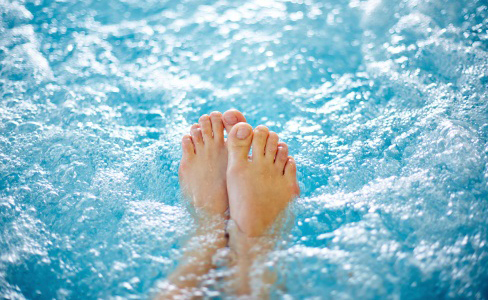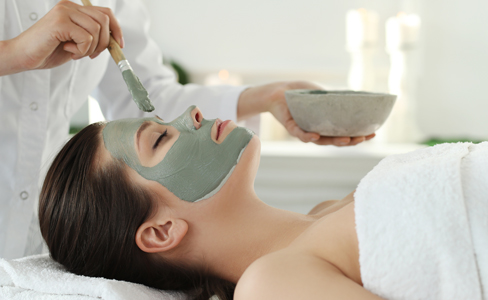You’re in Safe Hands about your Health
The core healing system that we practice in Ayurveda is Kerala's traditional Ayurvedic treatment for chronic disorders.
ACUPUNCTURE
Ancient traditional chinese medicine which uses the bodys own energy to help balance, re-align and ultimately heal itself. Acupuncture involves inserting needles at certain points of the body. Conditions it is used for include different kinds of pain, such as headaches, blood pressure problems, and whooping cough, among others. In 2003, the World Health Organization (WHO) listed a number of conditions in which they say acupuncture has been proven effective.

DIET THERAPY
Diet therapy is a broad term for the alteration or adoption of a diet to prevent or treat a disease or to simply promote optimum health. In some cases, an alternative dietary lifestyle plan may be developed to eliminate certain foods to reclaim health.
An incorrect diet can cause not only weight gain and skin conditions but may promote exhaustion and fatigue. Depending on the disease, if you do not follow the diet advised to you by a specialist it may have serious consequences on your health. A good diet can prevent various diseases.

HYDROTHERAPY
Hydrotherapy is the use of water, both internally and externally and at varying temperatures, for health purposes. Also known as water therapy or "water cures," hydrotherapy includes such therapeutic treatments as saunas, steam baths, foot baths, contrast therapy, sitz baths, and colonic cleansing.
It may act as a treatment for temporary skin-related issues, such as burns and septic ulcers, or for chronic health conditions, such as arthritis and fibromyalgia. Water therapy uses either hot or cold water, with the water pressure and flow varying among treatments. The intention is to ease both physical and mental symptoms

MUD THERAPY
Mud therapy is used for giving coolness to body. It dilutes and absorbs the toxic substances of body and ultimately eliminates them from body.
Mud is used successfully in different diseases like constipation, headache due to tension, high blood pressure, skin diseases etc

PHYSIOTHERAPY
It is a treatment method that focuses on the science of movement and helps people to restore, maintain and maximize their physical strength, motion, and overall well being by addressing the underlying physical issues.

YOGA THERAPY
Yoga therapy is the adaptation of yoga practices for people with health challenges. Yoga therapy includes specific regimens of postures, breathing exercises, and relaxation techniques to suit individual needs
it is a type of therapy that uses yoga postures, breathing exercises, meditation, and guided imagery to improve mental and physical health. The holistic focus of yoga therapy encourages the integration of mind, body, and spirit.
Yoga therapy is a growing field and scientific evidence has begun to emphasize its efficacy. It is used to treat existing mental and physical health issues, but can also be used as a self-care strategy for prevention and maintenance.

Process We Follow
We provide Ayurveda treatments for any condition and let we know what we can do for you and how long it would take. As a package, we do Rejuvenation treatment, weight gain and weight reduction treatment. Apart from that, we do treatments after doctor’s inference.
We have good success in rare conditions like COPD, Psoriasis, Stress, etc. and even common conditions like Infertility, Diabetes, Arthritis, etc
FAQ’s
Managed by professionally qualified Doctors
What are the issues treated by Yoga Therapy
Yoga therapy is a growing field and scientific evidence has begun to emphasize its efficacy. It is used to treat existing mental and physical health issues, but can also be used as a self-care strategy for prevention and maintenance.
Yoga therapy is well established as a treatment for depression and anxiety. A meta-analysis cited in the Primary Care Companion for CNS Disorders found that yoga therapy also shows promise for the treatment of posttraumatic stress (PTSD) and schizophrenia
Studies have shown that yoga boosts the neurotransmitter GABA (gamma-aminobutyric acid), which is important because GABA levels are statistically low in people who experience substance abuse, anxiety, and depression. Because of its concentration on mind and body integration, yoga therapy is also used to address many physical health issues. It has been effectively used to treat back pain, heart conditions, asthma, chronic fatigue, hypertension, multiple sclerosis, and side effects of chemotherapy.
Practice and Benefits of Yoga therapy
Yoga therapy is practiced in a wide range of formats. Physical therapists, for example, often implement yoga techniques in their delivery of massage and other treatments. Yoga therapy practice can resemble physical therapy, rehabilitative therapy, and/or psychotherapy. Unlike a standard yoga class, yoga therapy sessions are typically conducted in one-on-one or small group settings.
Yoga therapy can be provided as an adjunct therapy to complement other forms of treatment, or it can be used to directly treat a specific issue. Yoga techniques range from simple to advanced, and can be enjoyed by people of all ages.
What to expect from Yoga Therapy?
When a person decides to initiate yoga therapy, the therapist will first conduct an initial assessment. This assessment is designed to do the following:
○ Identify health problems
○ Assess lifestyle and physical capability
○ Discuss reasons for seeking therapy
○ Create a course of treatment
Once the treatment plan is established in this first consultation, the frequency of sessions is agreed upon and sessions are scheduled. From this point, therapy sessions will most likely include the following components:
○ Breathing Exercises (Prayanama): The doctor will guide the person in therapy through a series of breathing exercises ranging from energizing breaths to balancing breaths.
○ Physical Postures (Asana): The doctor will teach the person in treatment appropriate yoga poses that address problem areas. For example, the “Legs Up the Wall” pose is used to treat things like anxiety and insomnia. In this pose, the person lays on his or her back with legs positioned up against the wall.
○ Meditation: Relaxation and mindfulness are the focus of meditation when it is combined with yoga poses.
○ Guided Imagery: it attempts to calm the body and mind by providing a guided visualization intended to bring inner peace.
○ Homework: An important element for any yoga practice is to find a way to incorporate it into daily life.
Why is Diet therapy done?
For example, if it is to treat obesity or excess weight, weight loss is closely related to a decrease in the number of calories released in the body; in fact, the energy balance must be negative, that is, the calories consumed must be lower than those burned. This is achieved not only by integrating a sports activity into the patient's routine but also by changing the patient's eating habits.Diet therapy is not limited to weight loss: in fact, this treatment can prevent and treat a whole range of different diseases, with very different characteristics and the diet may depend on the nature of the disorder treated.
What are the benefits of Hydro Therapy?
○ Reducing pain - One reviewTrusted Source found that spa therapy using warm water had a significant pain-relieving effect in people with chronic diseases of the musculoskeletal system and connective tissues.
The warm water may ease the signals for pain, relax the muscles, and increase blood flow, reducing pain in the area.
○ Improving mental health
○ Arthritis symptoms
○ Low impact
○ Relaxation - Many forms of hydrotherapy also aid relaxation, both physically and mentallyTrusted Source. Warm water may help ease tension in the muscles while promoting a relaxed state of mind.
○ Recovering from workouts - Athletes sometimes use various forms of hydrotherapy in which they alternate between warm and cold water. Many feel that this form of contrast hydrotherapy helps them recover from hard workouts and avoid Trusted Sourcedelayed onset muscle soreness.
○ Pregnancy and hydrotherapy - Hydrotherapy may help with the general aches and pains that pregnancy can cause. Some people may chooseTrusted Source forms of hydrotherapy during a water birth to reduce pain and promote relaxation.
○ Physiological effects - The use of water has many physiologic effects. These effects are seen on the cardiopulmonary, circulatory, autonomic, and renal systems. Most appropriate to pain patients is the physiologic and therapeutic effects seen in patients with musculoskeletal pain. The primary therapeutic
effects of hydrotherapy are the promotion of muscle relaxation with decreased muscle spasm and increased ease of joint motion. Additionally, decreased pain sensitivity, reduction in gravitational forces, increase in circulation, increase in muscular strength, and improved balance
can be helpful in the rehabilitation of patients with chronic pain
What are the benefits of Hydro Therapy?
○ Reducing pain - One reviewTrusted Source found that spa therapy using warm water had a significant pain-relieving effect in people with chronic diseases of the musculoskeletal system and connective tissues.
The warm water may ease the signals for pain, relax the muscles, and increase blood flow, reducing pain in the area.
○ Improving mental health
○ Arthritis symptoms
○ Low impact
○ Relaxation - Many forms of hydrotherapy also aid relaxation, both physically and mentallyTrusted Source. Warm water may help ease tension in the muscles while promoting a relaxed state of mind.
○ Recovering from workouts - Athletes sometimes use various forms of hydrotherapy in which they alternate between warm and cold water. Many feel that this form of contrast hydrotherapy helps them recover from hard workouts and avoid Trusted Sourcedelayed onset muscle soreness.
○ Pregnancy and hydrotherapy - Hydrotherapy may help with the general aches and pains that pregnancy can cause. Some people may chooseTrusted Source forms of hydrotherapy during a water birth to reduce pain and promote relaxation.
○ Physiological effects - The use of water has many physiologic effects. These effects are seen on the cardiopulmonary, circulatory, autonomic, and renal systems. Most appropriate to pain patients is the physiologic and therapeutic effects seen in patients with musculoskeletal pain. The primary therapeutic
effects of hydrotherapy are the promotion of muscle relaxation with decreased muscle spasm and increased ease of joint motion. Additionally, decreased pain sensitivity, reduction in gravitational forces, increase in circulation, increase in muscular strength, and improved balance
can be helpful in the rehabilitation of patients with chronic pain
What is acupuncture?
Acupuncture involves inserting needles at certain points of the body. Conditions it is used for include different kinds of pain, such as headaches, blood pressure problems, and whooping cough, among others.
In 2003, the World Health Organization (WHO) listed a number of conditions in which they say acupuncture has been proven effective.
These include: High and low blood pressure, Chemotherapy-induced nausea and vomiting, Some gastric conditions including peptic ulcer, Painful periods, dysentery, allergic rhinitis, facial pain, morning sickness
rheumatoid arthritis, sprains, tennis elbow, sciatica, dental pain, reducing the risk of stroke, inducing labor Other conditions for which the WHO say that acupuncture may help but more evidence is needed include: fibromyalgia
neuralgia, post-operative convalescence, substance, tobaccor and alcohol dependence, spine pain, stiff neck, vascular dementia, whooping cough, or pertussis, Tourette syndrome, The WHO also suggest that it may help treat a number of infections, including some urinary tract infections and epidemic hemorrhagic fever.




